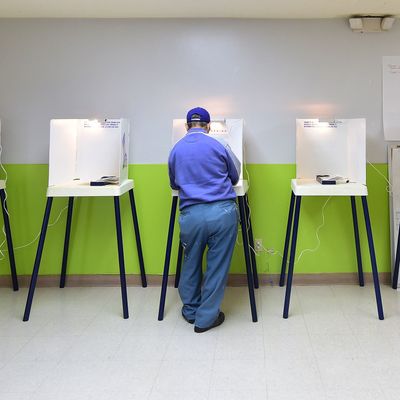
California’s June 5 primary could be a very big deal nationally. For one thing, the Golden State has seven Republican-held U.S. House seats in districts carried by Hillary Clinton in 2016, which makes it ground zero for the Democratic drive to take over the U.S. House. For another, California — with its heavily Democratic set of elected officials and its defiance of the Trump administration on a variety of issues — is considered a good test of whether “the resistance” to Trump has generated the kind of enthusiasm that can overcome the usual GOP advantage in midterm elections.
California’s unusual top-two primary system, moreover, potentially makes the June 5 results more important than primaries in other states, for the simple reason that one major political party or the other can be “locked out” of general elections if two candidates from the other party finish first and second in any given race. Democrats fear this could happen in several otherwise vulnerable GOP House seats, while Republicans are concerned they will have no general election candidates in the big statewide Senate and gubernatorial contests. The former possibility could be a blow to national Democratic hopes for a midterm “wave,” while the latter could depress GOP turnout in November.
Having said all that, it is very likely that voter turnout on June 5 will be terrible. Now, almost everywhere and at every time midterm turnout is lower than in presidential election years and primary turnout is lower than in general elections. But these gaps are particularly pronounced in California. In 2016 the general-election turnout was 75 percent of registered voters. In 2014 it was 42 percent, an all-time low for the state. In the 2016 primaries (which included a presidential primary) turnout was 48 percent. In 2014 — the first midterm held under the top-two system — primary turnout dropped to 25 percent, another all-time low.
The numbers may not be that bad on June 5, but they aren’t likely to be all that much better. That means the cost-effectiveness of going after any particular bloc of voters is enhanced, which may help explain the extraordinary gamesmanship going on this year, including deceptive campaign ads aimed at helping potential general election opponents. And primary turnout patterns in the recent past indicate that Republicans overall have a slight advantage in top-two primaries, as California political analyst John Myers notes:
A large part of the story is the disappearance of unaffiliated “independent” voters in primaries. The research suggests as many as 3.5 million of them might skip the June election. And because most of them lean Democratic (they are not nonpartisan, just loosely partisan), that’s another boost for Republicans.
That indifference seems especially ironic when you consider that California’s top-two primary — where political parties don’t limit participation — was custom-built for independents.
It’s hard to get a handle on the environment going into June 5 because of the heavy use of voting-by-mail in California, where it’s easy to register as a permanent by-mail voter and automatically receive ballots (which may or may not be returned). In the 2014 primary, 69 percent of the votes were cast by mail. That number is likely to go up significantly this year. The system will also create some uncertainty on Election Night, since mail ballots postmarked by June 5 and received by county election offices by June 8 will all eventually be counted.
So the excitement building in anticipation of the California primary among political junkies everywhere is not necessarily shared by the voters eligible to participate, and the outcomes could be mixed and slow to crystallize. If you live in the East, don’t bother staying up real late on June 5.






























